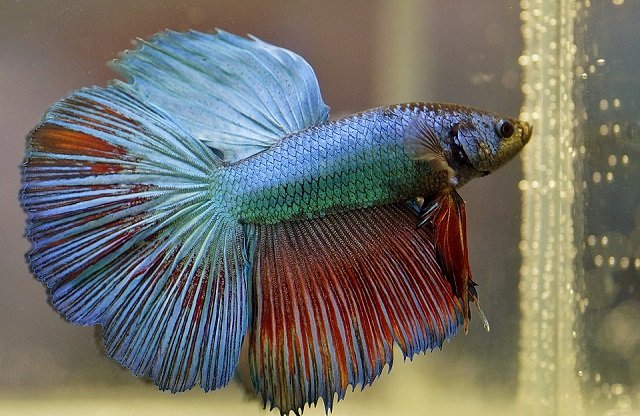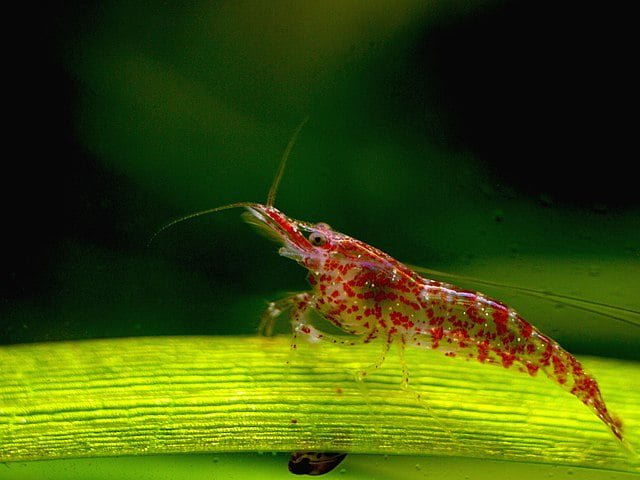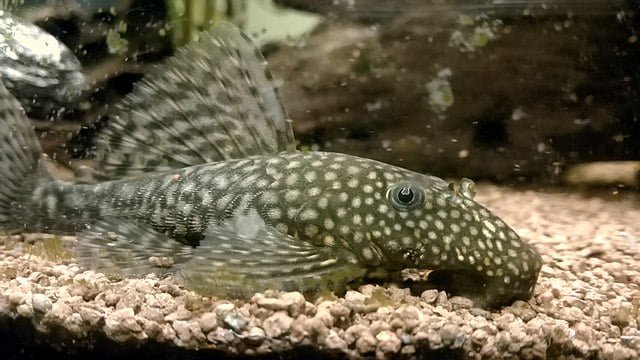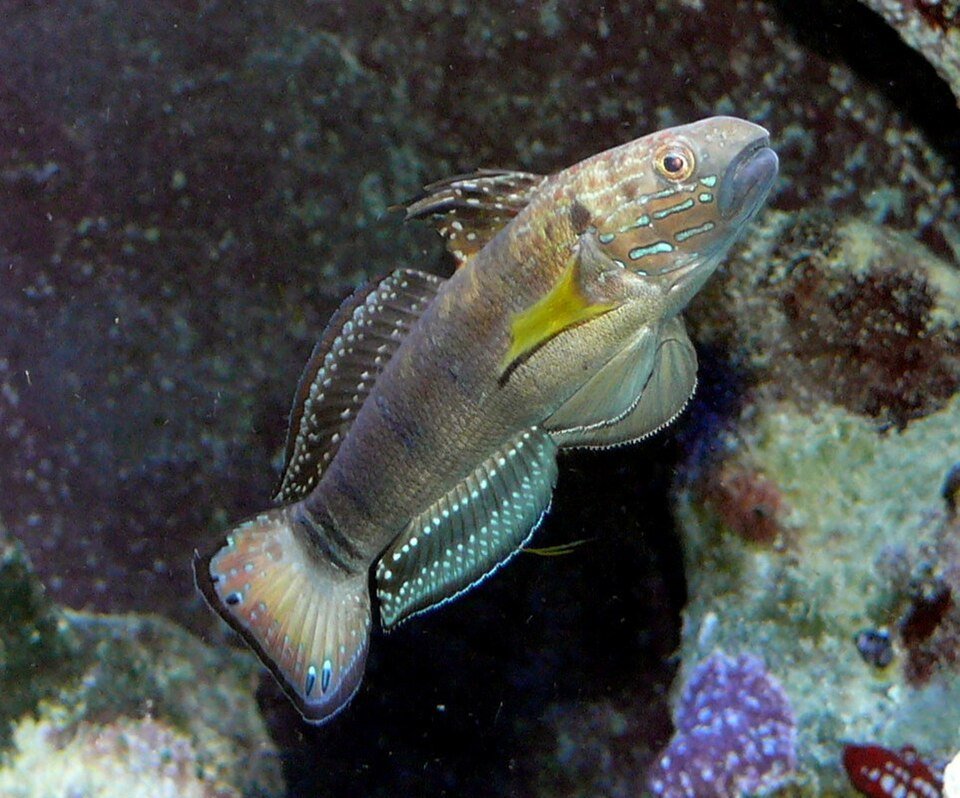
The “Sleeper Banded Goby” (Amblygobius phalaena) is a fish that has captured the attention of marine aquarium enthusiasts for its unique behavior and attractive appearance. This small fish not only adds a touch of color and movement to the aquarium but also plays a functional role by keeping the substrate clean and aerated.
In this article, we will explore in depth all aspects of the fascinating “Sleeper Banded Goby” Amblygobius phalaena, from its biology and behavior in the wild to the specific care it requires in a home aquarium. If you are considering adding this fish to your aquarium or are simply interested in learning more about marine life, this guide will provide you with all the information you need.
What is the Sleeper Banded Goby? Biology and characteristics
- 1 What is the Sleeper Banded Goby? Biology and characteristics
- 2 Natural habitat and distribution: From Japan to French Polynesia
- 3 Feeding the Sleeper Banded Goby
- 4 Reproduction: A ritual synchronized with the Moon
- 5 Keeping a healthy Sleeper Banded Goby in your aquarium
- 6 Compatibility: Who can the Sleeper Banded Goby live with?
- 7 Common diseases and prevention
- 8 Frequently Asked Questions (FAQ)
- 9 Conclusion: Is the Sleeper Banded Goby the right fish for You?
- 10 References
- 11 Entradas relacionadas:
To fully understand the needs and behavior of the Sleeper Banded Goby, it is essential to know its biology and intrinsic characteristics. This section delves into its taxonomic classification, the etymology of its name, its morphology, and its distribution in the world’s oceans.
Taxonomic classification: A look at its origins
The Sleeper Banded Goby belongs to the family Gobiidae, one of the most diverse fish families in the world, with over 2,000 described species. Its complete taxonomic classification is as follows:
- Kingdom: Animalia
- Phylum: Chordata
- Class: Actinopterygii
- Order: Gobiiformes
- Family: Gobiidae
- Genus: Amblygobius
- Species: Amblygobius phalaena
- Common name in Spanish: Gobio de barras marrones
- Common name in English: Sleeper Banded Goby, white-banded goby
This classification tells us that the Sleeper Banded Goby is a ray-finned fish, belonging to the vast group of gobies. Amblygobius phalaena is a small-sized species with a relatively short lifespan, with the oldest sampled individual living up to 14 months (Hernaman and Munday, 2005a).
Etymology: The meaning behind the name
The scientific name of a species often gives us clues about its characteristics. In the case of Amblygobius phalaena:
- Amblygobius: Derived from the Greek “amblys,” meaning “blunt” or “dull,” and “gobius,” which is the Latin name for a type of small fish, likely referring to the shape of its head.
- phalaena: This is a Latin word meaning “moth,” possibly alluding to its mottled coloration and its quick, short movements, which can resemble the flight of a moth.
Morphology and appearance of Amblygobius phalaena
The Sleeper Banded Goby (Amblygobius phalaena) has an elongated, cylindrical body that can reach a length of up to 10.7 centimeters (Froese, 2022). Its coloration is variable but generally features a light-colored background, ranging from white to pale yellow, with five dark brown to black vertical bars that give it its common name. The head is a greenish-yellow color and is adorned with iridescent blue and orange spots and stripes.
Stay Always Informed
Join our communities to instantly receive the most important news, reports, and analysis from the aquaculture industry.
One of its most notable adaptations is the absence of a swim bladder, an organ that most bony fish use to control their buoyancy. This lack is why gobies spend most of their time on the aquarium bottom, resting on their pelvic fins, which are fused to form a kind of suction cup that helps them adhere to surfaces. The mouth of the Sleeper Banded Goby is adapted for digging in the sand, an activity they constantly perform in search of food.
Natural habitat and distribution: From Japan to French Polynesia
The Sleeper Banded Goby (A. phalaena) has a wide distribution in the Indo-Pacific Ocean, from the east coast of Africa to the islands of French Polynesia, and from southern Japan to northern Australia. Daniel et al. (2018) reported the occurrence of Amblygobius phalaena for the first time in Indian waters.
Amblygobius phalaena is typically found in shallow coastal waters, at depths between 2 and 20 meters, in lagoons and bays with sand and coral rubble bottoms. These fish are natural burrowers and construct burrows in the sand, often under rocks or corals, which serve as a refuge from predators.
Feeding the Sleeper Banded Goby
Natural diet
In the wild, the Sleeper Banded Goby is an omnivore; according to the results of the study by Hernaman et al. (2009), the diet of A. phalaena is mainly composed of filamentous algae, harpacticoid copepods, other small crustaceans, and ostracods.
The feeding method of the Sleeper Banded Goby is distinctive: it takes mouthfuls of sand and filters it through its gills, retaining food particles and expelling the clean sand. This constant sand-sifting behavior helps keep the substrate oxygenated and free of detritus, making it an excellent “cleaner” for any reef aquarium.
Feeding in captivity
In the aquarium, the Sleeper Banded Goby (Amblygobius phalaena) will accept a wide variety of foods. It should be offered a varied diet that includes frozen foods like mysis and artemia, as well as prepared foods for herbivores and omnivores. Nori algae can also be offered. It is important to feed it several times a day in small quantities, as its metabolism is fast.
In the case of larvae, Chiu et al. (2025) recommend introducing artificial food starting from 35 days post-hatching (dph), when the larvae are 15.70–18.50 mm in length and have developed gastric glands. According to Chiu et al. (2024), the larvae of the Sleeper Banded Goby (A. phalaena) can consume both oyster trochophores and Euplotes sp. during the first feeding stage; the optimal feeding density of oyster trochophores was determined to be 10 individuals/mL.
An ally against pests? The Bryopsis myth
One of the reasons some aquarists are interested in the Sleeper Banded Goby is its supposed ability to eat Bryopsis. This filamentous alga can become a pest in reef aquariums. While it is true that this goby feeds on filamentous algae, there is no guarantee that it will eat Bryopsis specifically. Some individuals may do so, while others may ignore it completely. Therefore, the Sleeper Banded Goby should not be relied upon as the sole solution for a Bryopsis problem. Other more effective methods exist to control this alga, such as the use of ferric resins, commercial products like Kent Marine Tech M or Ultra Algae X, or the introduction of other more specialized herbivores.
Reproduction: A ritual synchronized with the Moon
The reproduction of the Sleeper Banded Goby (Amblygobius phalaena) is a fascinating process that is synchronized with lunar cycles. Spawning occurs approximately 1-13 days before the new moon and the full moon, suggesting a semilunar spawning pattern (Chiu et al. 2023). An important characteristic is that Amblygobius phalaena is monogamous (Takegaki, 2000). Furthermore, the average size at sexual maturity for males was 49.5 mm in total length (TL) at an average age of 4.8 months, while for females it was 59.9 mm TL at an average age of 6.0 months (Hernaman and Munday, 2005b).
During the spawning season, the male builds a nest in the sand, usually under a rock or in a cave; however, it is the female who initiates the reproductive behavior by gently pecking the male’s tail with her snout (Chiu et al. 2023). Finally, the female deposits her eggs in the nest, and the male fertilizes them. According to Chiu et al. (2023), fecundity ranged from 11,022 to 95,858 eggs per spawning event, with an average of 46,288 ± 6103 eggs; the egg has an average size of 1.64 mm (Trujillo-García et al. 2025).
It is the male of the Sleeper Banded Goby who is responsible for caring for the eggs, fanning them with his fins to keep them oxygenated and protecting them from predators until they hatch, which occurs 3 or 4 days after spawning (Chiu et al. 2023), at the expense of his own feeding (Takegaki, 2000). However, paired females of the goby Amblygobius phalaena can completely take over parental care of the eggs if the tending male is removed (Takegaki, 2005).
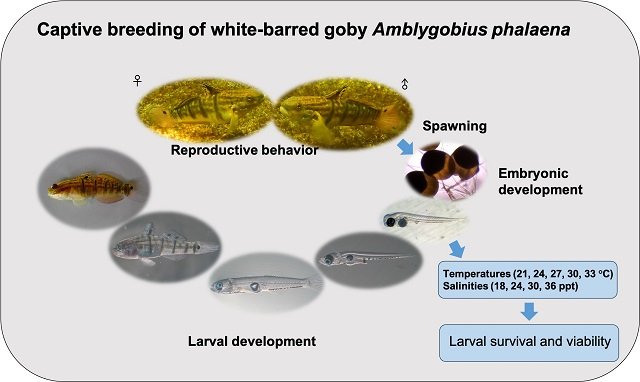
Chiu et al. (2023) described the larval development of the Sleeper Banded Goby:
- Newly hatched larvae had a total length (TL) of 1.91-2.03 mm with 24-26 somites.
- The mouth and anus opened at day 1 post-hatching (dph), and the yolk sac was completely absorbed by day 2 dph.
- The first feeding of the larvae occurred at day 2 dph, with a mouth gape height of 238.45-298.21 µm. Ciliates (Euplotes sp.), copepod nauplii (A. royi), and rotifers (B. rotundiformis) were used as the first live food.
- Larvae transformed into juveniles at 30 dph, reaching a TL of 9.95-13.47 mm (average 12.11 ± 0.48 mm). At this stage, the fin count reached the adult complement.
- The final average survival rate of juveniles to settlement was 1.92 ± 0.54%.
Keeping a healthy Sleeper Banded Goby in your aquarium
For your Sleeper Banded Goby (Amblygobius phalaena) to thrive in captivity, it is essential to provide an environment that resembles its natural habitat and meets its specific needs.
Tank requirements: Creating the perfect home
Providing the proper water quality conditions for raising the Sleeper Banded Goby (Amblygobius phalaena) in an aquarium is essential to ensure its well-being and health. In Table 1, we present information on water quality parameters.
Table 01. Water quality parameters for raising the Sleeper Banded Goby (Amblygobius phalaena).
| Parameter | Range |
| Tank size | 30 gallons (110 liters) for a pair. |
| Water temperature | 22-26 °C |
| Water pH | 8.1-8.4 |
| Salinity | 1.020-1.025 |
| Nitrates | <10 ppm |
| Ammonia and nitrites | 0 ppm |
Other recommendations include:
- Substrate: A fine sand substrate at least 5-7 cm deep is essential for the goby to dig and build its burrow.
- Lid: The Sleeper Banded Goby is an excellent jumper, so a secure lid on the aquarium is essential to prevent it from jumping out.
The importance of biogeochemistry and substrate ecology
The sand-sifting behavior of the Sleeper Banded Goby has a direct impact on the biogeochemistry and ecology of the aquarium substrate. By constantly turning over the sand, the goby helps prevent the formation of anaerobic zones, where toxic substances like hydrogen sulfide can accumulate. This process, known as bioturbation, is fundamental to maintaining a healthy reef ecosystem.
Compatibility: Who can the Sleeper Banded Goby live with?
The Sleeper Banded Goby is a peaceful fish that can be kept in a community aquarium with other fish of a similar temperament. However, it can be territorial with other gobies, especially those of its own species. If you want to keep more than one, it is best to do so in a large aquarium with plenty of space and hiding spots, or to try and form a pair.
Fascinating symbiosis: The Goby and the Pistol Shrimp
One of the most interesting interactions in the marine world is the symbiosis between gobies and pistol shrimps of the genus Alpheus. In this mutualistic relationship, the shrimp, which is nearly blind, is responsible for digging and maintaining a burrow for both, while the goby, with its excellent eyesight, acts as a sentinel, guarding the burrow entrance and alerting the shrimp to any danger with a quick flick of its tail. This fascinating symbiosis can be recreated in the aquarium, providing a natural and beneficial spectacle for both animals.
Common diseases and prevention
Like all marine fish, the Sleeper Banded Goby is susceptible to parasitic diseases such as Marine Ich (Cryptocaryon irritans) and Marine Velvet (Amyloodinium ocellatum). The best way to prevent these diseases is to maintain excellent water quality and to quarantine all new fish before introducing them to the main aquarium.
Frequently Asked Questions (FAQ)
Is the Sleeper Banded Goby suitable for beginners?
Yes, it is a hardy and relatively easy fish to care for, as long as it is provided with a suitable aquarium and a varied diet.
Will it really clean my sand?
Yes, its natural sand-sifting behavior will help keep the substrate clean and aerated.
Can it live with other gobies?
It can be territorial with other gobies, so caution is recommended.
Does it need a pistol shrimp to live?
No, it is not necessary, but the symbiosis between the two is a fascinating spectacle to observe.
Is it “reef safe”?
Yes, it is completely reef safe and will not bother corals or other invertebrates.
How big does it grow?
It can reach a length of up to 15 cm.
What is its lifespan?
With proper care, it can live for several years in an aquarium.
Conclusion: Is the Sleeper Banded Goby the right fish for You?
The Sleeper Banded Goby (Amblygobius phalaena) is a fascinating and useful fish that can be an excellent addition to any reef aquarium. Its active behavior and attractive appearance make it a highly appreciated fish by aquarists. If you are looking for a fish that is not only beautiful but also contributes to maintaining the health of your aquarium, the Sleeper Banded Goby is undoubtedly an excellent choice.
References
Chiu, P.-S., Ho, S.-W., Huang, C.-H., Lee, Y.-C., & Lin, Y.-H. (2023). Captive Reproductive Behavior, Spawning, and Early Development of White-Barred Goby Amblygobius phalaena (Valenciennes, 1837) and Examined Larval Survival and Viability at Different Water Temperatures and Salinities. Fishes, 8(7), 364. https://doi.org/10.3390/fishes8070364
Chiu, P., Ho, S., Hsu, J., Huang, C., Lee, Y., & Lin, Y. (2024). First feeding of a marine ornamental fish, the White-barred Goby Amblygobius phalaena: Investigating the optimal initial live feed organisms and optimal feeding density. North American Journal of Aquaculture, 86(2), 214-227. https://doi.org/10.1002/naaq.10326
Chiu, P.-S., Hsu, J., Ho, S.-W., Huang, C.-H., Lee, Y.-C. and Lin, Y.-H. (2025), Development of the Digestive System and Digestive Enzymes in the Marine Ornamental Fish White-Barred Goby Amblygobius phalaena. Journal of Animal Physiology and Animal Nutrition. https://doi.org/10.1111/jpn.14135
Daniel, N., Pavan-Kumar, A., Kiruba-Sankar, Praveenraja, Kathirvel Pandian, A., Dam Roy, S., & Chaudhari, A. (2018). First record of whitebarred goby Amblygobius phalaena (Valenciennes, 1837) from Indian waters. Indian Journal of Fisheries, 65(3), 116-121. https://doi.org/10.21077/ijf.2018.65.3.75145-16
Froese, R. (2022). Estimating somatic growth of fishes from maximum age or maturity. Acta Ichthyologica et Piscatoria, 52(2), 125-133. DOI 10.3897/aiep.52.80093.
Hernaman V, Munday PL (2005a) Life-history characteristics of coral reef gobies. I. Growth and life-span. Mar Ecol Prog Ser 290:207-221 https://doi.org/10.3354/meps290207
Hernaman V, Munday PL (2005b) Life-history characteristics of coral reef gobies. II. Mortality rate, mating system and timing of maturation. Mar Ecol Prog Ser 290:223-237 https://doi.org/10.3354/meps290223
Hernaman, V., Probert, P.K. & Robbins, W.D. Trophic ecology of coral reef gobies: interspecific, ontogenetic, and seasonal comparison of diet and feeding intensity. Mar Biol 156, 317–330 (2009). https://doi.org/10.1007/s00227-008-1085-x
Takegaki, T. Monogamous Mating System and Spawning Cycle in the Gobiid Fish, Amblygobius phalaena (Gobiidae). Environmental Biology of Fishes 59, 61–67 (2000). https://doi.org/10.1023/A:1007651718465
Takegaki T. Female egg care subsequent to removal of egg-tending male in a monogamous goby, Amblygobius phalaena (Gobiidae): a preliminary observation. Journal of the Marine Biological Association of the United Kingdom. 2005;85(1):189-190. doi:10.1017/S0025315405011045h
Trujillo-García, M., Ceballos-Vázquez, B. P., Guevara-Fiore, P., & Klug, H. (2025). An Overview of Post-Fertilization Parental Care in Gobiidae. Diversity, 17(7), 446. https://doi.org/10.3390/d17070446
Editor at the digital magazine AquaHoy. He holds a degree in Aquaculture Biology from the National University of Santa (UNS) and a Master’s degree in Science and Innovation Management from the Polytechnic University of Valencia, with postgraduate diplomas in Business Innovation and Innovation Management. He possesses extensive experience in the aquaculture and fisheries sector, having led the Fisheries Innovation Unit of the National Program for Innovation in Fisheries and Aquaculture (PNIPA). He has served as a senior consultant in technology watch, an innovation project formulator and advisor, and a lecturer at UNS. He is a member of the Peruvian College of Biologists and was recognized by the World Aquaculture Society (WAS) in 2016 for his contribution to aquaculture.
